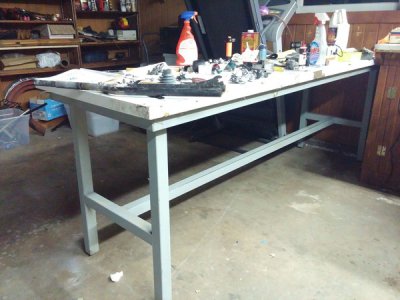Well, as it turns out, the early Atlas catalogs say that the top board supplied with the 6" floor stands was only 1-5/8" thick. So 1-1/4" isn't too far off. Unfortunately, none of the 6" stand ads give the length and width. The board was mounted to cast iron legs that were wider apart at the floor than the width of the board. If you use vertical legs, and a wider top, weld in diagonal braces.
Most if not all photographs of the 101.07301 show the motor sticking out to the left of the headstock. I never understood that. Most 618 photos show the motor straight behind the headstock. If it will fit under the countershaft on the 101.07301, I would recommend that configuration. For one thing, it is shorter.
Another consideration is how you are going to level the stand. You should do that first before then precision leveling the bed. Although it is not in point of fact necessary that the bed be dead level, without seriously expensive equipment (in the $100K range and up), there is no low cost way to be sure that the bed is dead straight other than by making sure that it is dead level.
 Good news is the old Craftsman motor I remember from grandpa's garage did in fact get saved when when we had the estate sale before selling their house a decade or so ago, so I'll be digging that out of dad's shed sometime soon. It's definitely of a similar vintage, it was old when dad was young.
Good news is the old Craftsman motor I remember from grandpa's garage did in fact get saved when when we had the estate sale before selling their house a decade or so ago, so I'll be digging that out of dad's shed sometime soon. It's definitely of a similar vintage, it was old when dad was young.
